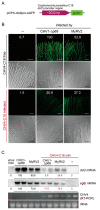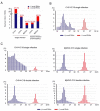Identification of an RNA Silencing Suppressor Encoded by a Symptomless Fungal Hypovirus, Cryphonectria Hypovirus 4
- PMID: 33572564
- PMCID: PMC7912522
- DOI: 10.3390/biology10020100
Identification of an RNA Silencing Suppressor Encoded by a Symptomless Fungal Hypovirus, Cryphonectria Hypovirus 4
Abstract
Previously, we have reported the ability of a symptomless hypovirus Cryphonectria hypovirus 4 (CHV4) of the chestnut blight fungus to facilitate stable infection by a co-infecting mycoreovirus 2 (MyRV2)-likely through the inhibitory effect of CHV4 on RNA silencing (Aulia et al., Virology, 2019). In this study, the N-terminal portion of the CHV4 polyprotein, termed p24, is identified as an autocatalytic protease capable of suppressing host antiviral RNA silencing. Using a bacterial expression system, CHV4 p24 is shown to cleave autocatalytically at the di-glycine peptide (Gly214-Gly215) of the polyprotein through its protease activity. Transgenic expression of CHV4 p24 in Cryphonectria parasitica suppresses the induction of one of the key genes of the antiviral RNA silencing, dicer-like 2, and stabilizes the infection of RNA silencing-susceptible virus MyRV2. This study shows functional similarity between CHV4 p24 and its homolog p29, encoded by the symptomatic prototype hypovirus CHV1.
Keywords: Cryphonectria parasitica; Dicer; RNA silencing; RNAi suppressor; chestnut blight fungus; co-infection; hypovirus; mycovirus; reovirus.
Conflict of interest statement
The authors declare no conflict of interest.
Figures






Similar articles
-
A symptomless hypovirus, CHV4, facilitates stable infection of the chestnut blight fungus by a coinfecting reovirus likely through suppression of antiviral RNA silencing.Virology. 2019 Jul;533:99-107. doi: 10.1016/j.virol.2019.05.004. Epub 2019 May 18. Virology. 2019. PMID: 31146252
-
Hypovirus papain-like protease p29 suppresses RNA silencing in the natural fungal host and in a heterologous plant system.Eukaryot Cell. 2006 Jun;5(6):896-904. doi: 10.1128/EC.00373-05. Eukaryot Cell. 2006. PMID: 16757737 Free PMC article.
-
Comparative analysis of alterations in host phenotype and transcript accumulation following hypovirus and mycoreovirus infections of the chestnut blight fungus Cryphonectria parasitica.Eukaryot Cell. 2007 Aug;6(8):1286-98. doi: 10.1128/EC.00166-07. Epub 2007 Jun 8. Eukaryot Cell. 2007. PMID: 17557883 Free PMC article.
-
The chestnut blight fungus for studies on virus/host and virus/virus interactions: from a natural to a model host.Virology. 2015 Mar;477:164-175. doi: 10.1016/j.virol.2014.09.024. Epub 2014 Nov 4. Virology. 2015. PMID: 25454384 Review.
-
Hypovirus molecular biology: from Koch's postulates to host self-recognition genes that restrict virus transmission.Adv Virus Res. 2013;86:109-47. doi: 10.1016/B978-0-12-394315-6.00005-2. Adv Virus Res. 2013. PMID: 23498905 Review.
Cited by
-
Mycovirus-encoded suppressors of RNA silencing: Possible allies or enemies in the use of RNAi to control fungal disease in crops.Front Fungal Biol. 2022 Oct 10;3:965781. doi: 10.3389/ffunb.2022.965781. eCollection 2022. Front Fungal Biol. 2022. PMID: 37746227 Free PMC article. Review.
-
The Expanding Mycovirome of Aspergilli.J Fungi (Basel). 2024 Aug 17;10(8):585. doi: 10.3390/jof10080585. J Fungi (Basel). 2024. PMID: 39194910 Free PMC article. Review.
-
Uncovering a Complex Virome Associated with the Cacao Pathogens Ceratocystis cacaofunesta and Ceratocystis fimbriata.Pathogens. 2023 Feb 9;12(2):287. doi: 10.3390/pathogens12020287. Pathogens. 2023. PMID: 36839559 Free PMC article.
-
Diversity of mycoviruses in edible fungi.Virus Genes. 2022 Oct;58(5):377-391. doi: 10.1007/s11262-022-01908-6. Epub 2022 Jun 6. Virus Genes. 2022. PMID: 35668282 Review.
-
Proteome expansion in the Potyviridae evolutionary radiation.FEMS Microbiol Rev. 2022 Jul 1;46(4):fuac011. doi: 10.1093/femsre/fuac011. FEMS Microbiol Rev. 2022. PMID: 35195244 Free PMC article. Review.
References
Grants and funding
LinkOut - more resources
Full Text Sources
Other Literature Sources

